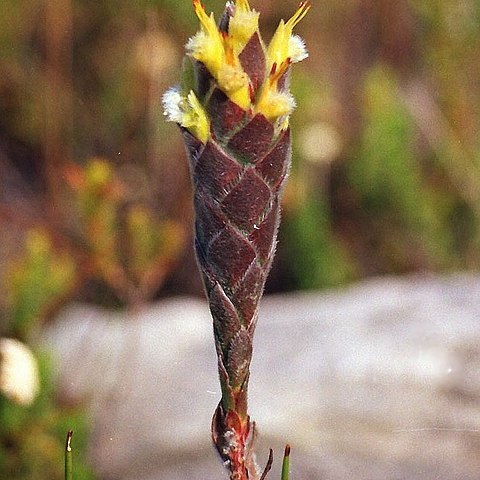Low suberect shrub to 0.5 m (very rarely to 1 m) in height, up to 0.7 m in diam., with a single main stem to 5 mm in diam.; bark brown. Main stem branching at 50-100 mm, giving rise to a few erect, vigorous, unbranched shoots and numerous lax, laterally sprawling occasionally dichotomous branches; stems 1.5-3 mm in diam., villous, becoming glabrous. Erect shoots producing vigorous inflorescences with 5-12 capitula, laterally sprawling branches bearing 2 or 3 capitula or occasionally a single terminal capitulum. Leaves lanceolate-elliptic, 15-20 mm long, 5-10 mm wide, markedly patent on lower branches becoming very broadly ovate, 20 mm long by 15 mm wide and imbricate to clasping on vigorous upright shoots; acute, entire with a small apical callus; densely villous, margins villous-ciliate, later glabrescent. Inflorescence narrowly cylindric, 10-45 mm long, consisting of 5-12 axillary capitula. Capitula 35 mm long, 3-6-flowered, subtended by a green undifferentiated foliage leaf. Involucral bracts imbricate, clasping perianths at anthesis; outer bracts linear-lanceolate, 15-20 mm long, 2-4 mm wide, green and foliaceous; inner bracts narrowly lanceolate to lanceolate-elliptic, 20-30 mm long, 4-10 mm wide, sharply acute, papyraceous, outer surface sparsely sericeous. Floral bracts linear, narrowly lanceolate, 10 mm long, outer surface very densely sericeous. Perianth 20-25 mm long; tube quadrangular, 2-3 mm long, glabrous; claws filiform, sericeous, limbs linear-filiform, acute, not differentiated from claws, sericeous to glabrescent. Anthers sessile, 2 mm long. Style 35 mm long, straight to slightly abaxially arcuate. Pollen presenter linear, acute, 2 mm long, with a geniculate annular thickening at junction with style. Ovary ovoid, 1-2 mm long, densely puberulous except on adaxial quarter. Hypogynous scales linear-subulate, 1 mm long. Fruits cylindric, grey-brown, beaked apically, ventral suture prominent, minutely puberulous. Mimetes palustris has a rather ill-defined flowering period though it is best described as winter-flowering. The capitula in each inflorescence open sporadically over a period of time, from early July until late November.
More
Sprawling, single-stemmed shrub sometimes to 1 m. Leaves lanceolate-elliptic, clasping stem, shaggy; inflorescence leaves similar. Flower heads in terminal spikes, white, involucral bracts yellow-green, style yellow with red tip, fading red, pollen presenter needle-like, swollen at base.


